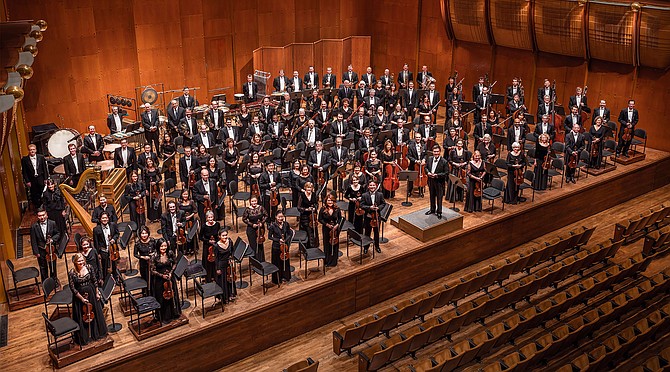 Facebook
Facebook
 X
X
 Instagram
Instagram
 TikTok
TikTok
 Youtube
Youtube

The New York Philharmonic gave a concert at Symphony Hall on Wednesday night, May 4. It was loud.
The concert was presented by the La Jolla Music Society as a part of their Celebrity Orchestra Series.
There are a few ways to speak of the performance. One would be an experience of riveting rhythmic energy as every single nuance of Beethoven and Sibélius was emphasized and expressed.
Another would be an experience of Beethoven and Sibélius which emphasized the rhythms to such an extent that the music was distorted and the line was nonexistent.
I oscillated between the two for the entire concert. There were sections music when maestro Alan Gilbert's approach made sense and the effect was dazzling.
There were sections when the rhythmic structure was overbearing and the effect was disappointing. It felt as though Gilbert was determined to keep any hint of sentimentality out of the music.
I'm unsure of Gilbert's intention in removing the sentiment. It could be that he is trying to create an accurate representation of the music in order to allow the composer to be preeminent.
The Beethoven segment of the concert, Egmont Overture and Symphony No. 7, were impressive, but I was unmoved. The ability of the orchestra was thrilling, but it felt as though they were attached to the rhythm of the music to the detriment of the line.
The concert was not all impressive feats of “squared-off” rhythms. The Sibélius Symphony No. 7 was a revelation. The orchestra settled down after the victorious conclusion of Beethoven’s Seventh and the glory of Sibélius’s vision was revealed. The brass, which had been aggressive if not downright arrogant in Beethoven, blunted their swords and let the golden glow of Sibélius shine on the audience.
The concert concluded with Sibélius’s Finlandia and then an encore of Sibélius’s Valse Triste.


The New York Philharmonic gave a concert at Symphony Hall on Wednesday night, May 4. It was loud.
The concert was presented by the La Jolla Music Society as a part of their Celebrity Orchestra Series.
There are a few ways to speak of the performance. One would be an experience of riveting rhythmic energy as every single nuance of Beethoven and Sibélius was emphasized and expressed.
Another would be an experience of Beethoven and Sibélius which emphasized the rhythms to such an extent that the music was distorted and the line was nonexistent.
I oscillated between the two for the entire concert. There were sections music when maestro Alan Gilbert's approach made sense and the effect was dazzling.
There were sections when the rhythmic structure was overbearing and the effect was disappointing. It felt as though Gilbert was determined to keep any hint of sentimentality out of the music.
I'm unsure of Gilbert's intention in removing the sentiment. It could be that he is trying to create an accurate representation of the music in order to allow the composer to be preeminent.
The Beethoven segment of the concert, Egmont Overture and Symphony No. 7, were impressive, but I was unmoved. The ability of the orchestra was thrilling, but it felt as though they were attached to the rhythm of the music to the detriment of the line.
The concert was not all impressive feats of “squared-off” rhythms. The Sibélius Symphony No. 7 was a revelation. The orchestra settled down after the victorious conclusion of Beethoven’s Seventh and the glory of Sibélius’s vision was revealed. The brass, which had been aggressive if not downright arrogant in Beethoven, blunted their swords and let the golden glow of Sibélius shine on the audience.
The concert concluded with Sibélius’s Finlandia and then an encore of Sibélius’s Valse Triste.
Comments